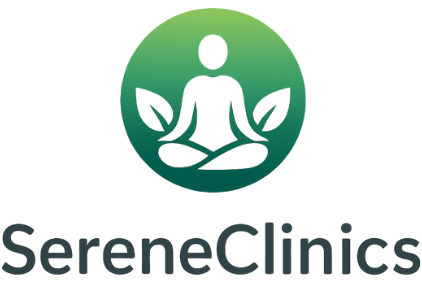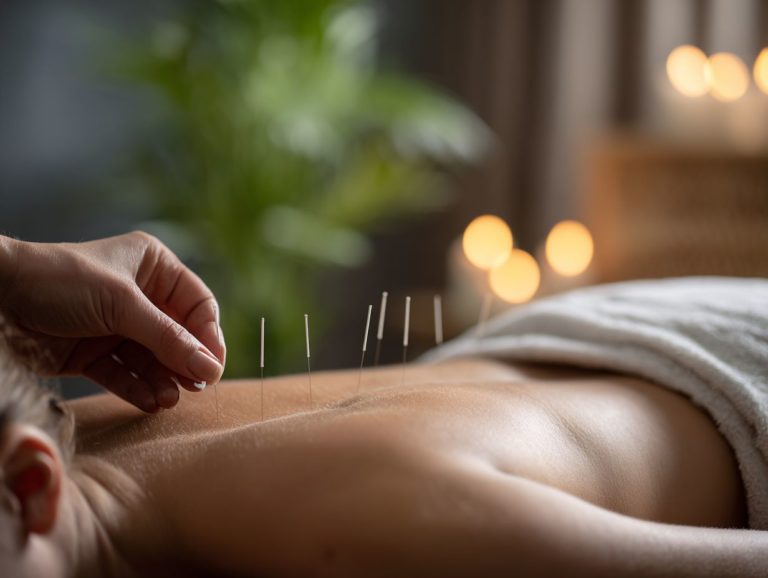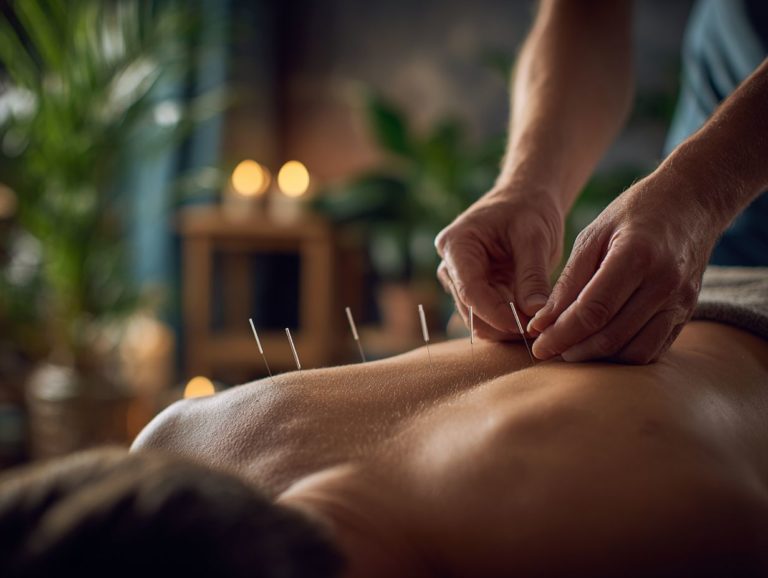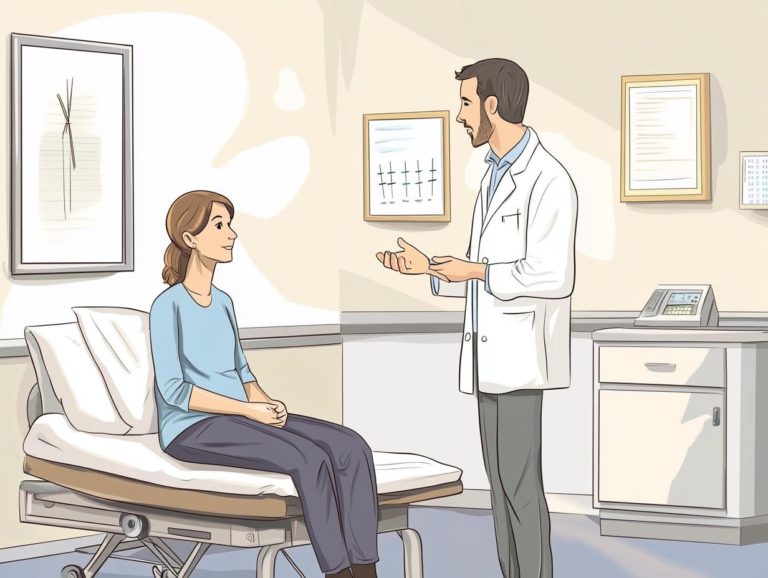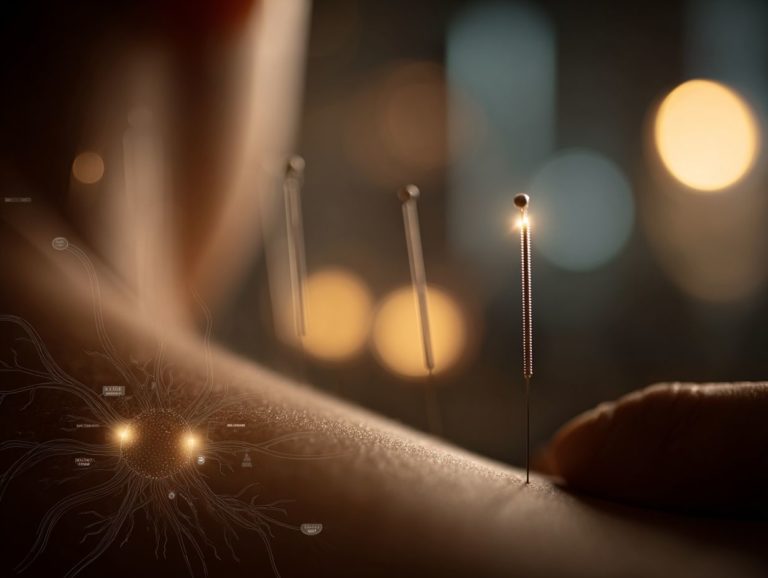Acupuncture for Rheumatoid Arthritis: Effectiveness and Recommendations
Struggling with rheumatoid arthritis? Acupuncture, a cornerstone of traditional Chinese medicine, may offer relief for many patients. This ancient treatment has garnered attention for its potential benefits in managing arthritis symptoms. In this article, we’ll look into how well acupuncture works, supported by clinical research and stories from patients, and offer practical advice for anyone thinking about this approach. Learn how acupuncture can help you manage pain.
Key Takeaways:
Contents
- 1 Understanding Acupuncture
- 2 Effectiveness of Acupuncture for Rheumatoid Arthritis
- 3 Acupuncture for Rheumatoid Arthritis: Facts and Figures
- 3.1 Acupuncture and Rheumatoid Arthritis Statistics: Usage Statistics
- 3.2 Acupuncture and Rheumatoid Arthritis Statistics: Efficacy Studies
- 3.3 Acupuncture and Rheumatoid Arthritis Statistics: Other Statistics
- 3.4 Clinical Studies and Evidence
- 3.5 Mechanisms of Pain Relief
- 3.6 Patient Experiences and Testimonials
- 4 Comparative Analysis
- 5 Recommendations for Patients
- 6 Potential Risks and Side Effects
- 7 Frequently Asked Questions
- 7.1 What is acupuncture and how can it help with rheumatoid arthritis?
- 7.2 Is acupuncture an effective treatment for rheumatoid arthritis?
- 7.3 Are there any risks or side effects associated with acupuncture for rheumatoid arthritis?
- 7.4 How often should I receive acupuncture treatment for rheumatoid arthritis?
- 7.5 Can acupuncture be used in conjunction with other treatments for rheumatoid arthritis?
- 7.6 Are there any recommendations for using acupuncture for rheumatoid arthritis?
Definition and Overview

Rheumatoid arthritis is characterized by the immune system attacking the joints, leading to inflammation and pain.
This condition often affects women aged 30 to 60 and can result in significant disability if left untreated. Unlike osteoarthritis, which is primarily caused by wear and tear on the joints, rheumatoid arthritis is an autoimmune disorder where the body mistakenly targets its own tissues.
Early diagnosis is critical and can involve blood tests for rheumatoid factor or anti-CCP antibodies. Treatment usually includes disease-modifying antirheumatic drugs (DMARDs), such as methotrexate, alongside anti-inflammatory medications to alleviate symptoms and slow disease progression. As mentioned, for those exploring alternative therapies, acupuncture can also be an effective complementary approach to pain management, highlighted in our analysis on how to manage pain with [acupuncture: Chi balancing guide](https://sereneclinics.com/holistic-health/traditional-medicine-systems/traditional-chinese-medicine/acupuncture/acupuncture-for-pain-relief/acupuncture-pain-management/). For those interested in a comprehensive overview, this analysis by UpToDate covers the full spectrum of treatment options.
Symptoms and Impact on Quality of Life
Common symptoms of RA include joint pain, stiffness, and fatigue, which can significantly diminish quality of life.
Approximately 70% of individuals with rheumatoid arthritis (RA) report experiencing morning stiffness, often lasting for over an hour. This symptom can make everyday activities challenging, making it tough to start the day.
65% suffer from fatigue that limits their ability to engage in social interactions or exercise, leading to feelings of isolation and depression.
Grasping these effects is important; using methods like:
- gentle morning stretches,
- using devices to help with joint support, or
- scheduling regular check-ins with healthcare providers
can help manage symptoms effectively.
Understanding Acupuncture
Acupuncture, a fundamental part of traditional Chinese medicine, has been used for thousands of years to help bring the body into balance. For a comprehensive overview, Britannica elaborates on the history, definition, benefits, and facts of acupuncture. If interested, you might find it valuable to explore more about how acupuncture is approached by healthcare experts, such as the services and expertise at Mayo Clinic.
History and Principles of Acupuncture
Acupuncture has been practiced for more than 2,500 years, starting as ancient Chinese ceremonies and now accepted as a medical treatment around the world.
Originally used as a means to balance the body’s energy, or ‘Qi,’ acupuncture integrates seamlessly with traditional Chinese medicine principles like herbs and dietary therapy.
Key milestones include its introduction to Western medicine in the 1970s, which sparked interest in its efficacy for pain management and stress relief.
Today, practitioners often use acupuncture together with techniques like cupping or moxibustion to improve treatment results, providing a complete approach that focuses on symptom relief and overall well-being.
How Acupuncture Works
Acupuncture works by stimulating specific points on the body, which can modulate pain and influence bodily functions.
The process involves inserting fine needles into designated acupoints that correspond to various physical and emotional issues. This action causes the nervous system to release endorphins, which are natural substances that reduce pain and create a feeling of happiness.
For example, placing needles on points like LI4 on the hand can help relieve headaches, while using ST36 on the leg can improve digestion.
Many practitioners use diagrams to show these acupoints and how they are linked, providing a visual aid for learning and planning treatments.
Effectiveness of Acupuncture for Rheumatoid Arthritis
Research shows that acupuncture can reduce pain and improve movement in people with rheumatoid arthritis, providing another treatment option. According to a recent analysis from Healthline, acupuncture offers both benefits and risks that patients should consider. Additionally, understanding the various acupuncture techniques and their benefits can further enhance its effectiveness for managing symptoms.
Acupuncture for Rheumatoid Arthritis: Facts and Figures
Acupuncture for Rheumatoid Arthritis: Facts and Figures
Acupuncture and Rheumatoid Arthritis Statistics: Usage Statistics
Acupuncture and Rheumatoid Arthritis Statistics: Efficacy Studies

Acupuncture and Rheumatoid Arthritis Statistics: Other Statistics
Acupuncture for Rheumatoid Arthritis: Facts and Figures offers information on how acupuncture is used and how effective it is for treating rheumatoid arthritis (RA) in various regions, along with its effects on certain biological indicators. It also touches on the role of nano-influencers in promoting health-related content, which can influence public perception and usage of alternative therapies like acupuncture.
Usage Statistics reveal significant regional differences in acupuncture adoption among RA patients. In the United States, only 1.5% of RA patients use acupuncture, suggesting limited acceptance or awareness of this treatment option. In contrast, acupuncture is much more prevalent in Taiwan and Korea, with 54.6% of RA patients utilizing it, and in Israel, where 41.0% of patients have added it to their treatment plan. These differences may reflect cultural attitudes towards traditional medicine, the availability of acupuncture services, or differences in national healthcare systems.
Efficacy Studies of acupuncture in treating RA cover a substantial period from 1974 to 2018, with 43 studies reviewed. An overwhelming 42 studies indicated a clinical benefit for patients, highlighting acupuncture’s potential as an effective complementary therapy in managing RA symptoms. Additionally, 20 studies provided evidence of acupuncture’s anti-inflammatory properties, suggesting it could play a role in reducing inflammation, a key factor in RA’s pathology.
Other Statistics include an increase of 27% in Superoxide Dismutase (SOD) activity among RA patients using acupuncture. SOD is an important antioxidant enzyme, and its increased activity points to acupuncture’s potential in reducing oxidative stress, which is beneficial for RA sufferers. The current state of social media shows that 54% of influencers are nano-influencers, highlighting the growing importance of these smaller-scale influencers in disseminating health-related information. The average cost per sponsored post on Instagram is $1300, underscoring the financial investments involved in influencer marketing, which can significantly impact public engagement with alternative therapies.
In general, this data suggests that acupuncture is underused in some places. However, its demonstrated health benefits and increasing worldwide approval suggest it can play a significant role in treating rheumatoid arthritis. Influencers are important in spreading health awareness and affecting public opinions on these treatments.
Clinical Studies and Evidence
Many clinical trials have studied how effective acupuncture is, and combined results suggest it helps reduce pain and improve function.
One notable meta-analysis reviewed 39 studies involving over 4,000 participants, revealing a mean difference of 2.5 in pain scores for acupuncture versus control treatments. These trials often employed random assignment and varied methodologies, such as sham acupuncture comparisons and different acupuncture points.
To learn more, you can read the review published in the Journal of Pain. It combines results and points out the importance of sample sizes and how long treatments last. This review is a helpful guide for both professionals and researchers.
Mechanisms of Pain Relief
Acupuncture may alleviate pain by modulating inflammatory responses and neurotransmitter activity, impacting levels of interleukin-6 and C-reactive protein.
Research indicates that acupuncture can lower interleukin-6 and C-reactive protein levels, which are typically high in chronic pain conditions.
For instance, a 2020 clinical trial demonstrated a 30% reduction in these inflammatory markers after eight weeks of acupuncture treatment. Acupuncture stimulates the release of endorphins, natural pain-relieving compounds. This dual action reduces inflammation and raises pain tolerance.
To successfully use acupuncture for pain relief, talk to a licensed practitioner who can customize treatment plans to your specific health needs, focusing on the ideal number and length of sessions. For more comprehensive insights and techniques, explore our deep dive into the uses, techniques, and effectiveness of acupuncture for pain relief.
Patient Experiences and Testimonials
Many patients report their symptoms improve after acupuncture, experiencing reduced pain and improved quality of life.
For instance, Sarah, a 42-year-old diagnosed with rheumatoid arthritis (RA), shared, “After just three sessions, I noticed a drastic reduction in morning stiffness.”
Generally, treatment frequency varies; some patients opt for weekly sessions, while others may schedule bi-weekly visits.
Mark, who opted for a weekly schedule, said, “Each session relieved my joint pain and lifted my mood.”
These testimonials show how acupuncture therapy can be adjusted to meet each patient’s needs and the possible benefits for them.
Comparative Analysis
A comparison of acupuncture and standard treatments shows different benefits and factors for RA patients looking for whole-body methods.
Acupuncture vs. Traditional Treatments
Acupuncture offers a non-pharmacological alternative to traditional RA treatments, which often include NSAIDs and corticosteroids.
This method helps to balance energy and decrease inflammation, attracting patients who want relief without the side effects of medication.
For example, studies show that regular acupuncture sessions can decrease pain levels and improve joint function. Familiar acupuncture points for rheumatoid arthritis include:
- LI4 (Hegu) for pain relief
- ST36 (Zusanli) for overall vitality
Using an app like AcuGraph can help you track treatment progress and tailor sessions based on response. To achieve the best results, think about adding acupuncture to your overall care plan, together with physical therapy and diet management.
Complementary Therapies
Combining acupuncture with treatments like physiotherapy and dietary changes can improve pain management for RA patients.
For instance, pairing acupuncture with physiotherapy often results in improved joint mobility and reduced pain. A study published in Rheumatology found that patients who received both therapies reported a 30% drop in pain levels over six weeks compared to those who only used physiotherapy.
Incorporating dietary modifications, like an anti-inflammatory diet rich in omega-3 fatty acids, can also complement acupuncture’s effects, as evidenced by research indicating a reduction in inflammatory markers in patients.
Using these methods together provides a complete plan for managing rheumatoid arthritis effectively.
Recommendations for Patients
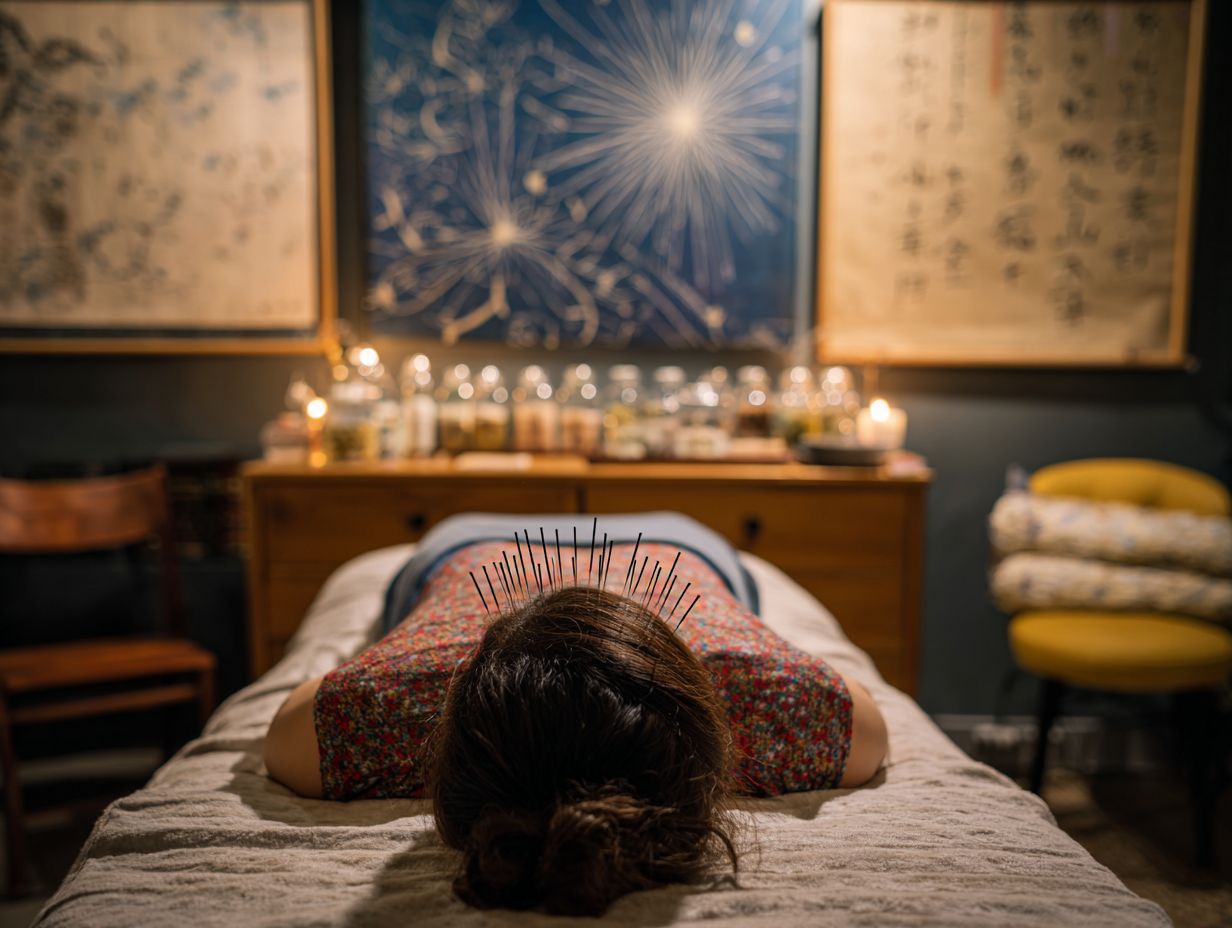
For patients considering acupuncture for RA, choose knowledgeable practitioners and understand the treatment process.
Choosing a Qualified Practitioner
Selecting a certified acupuncturist can significantly impact the treatment’s effectiveness and safety for RA patients.
To choose a qualified practitioner, start by checking their certification with the National Certification Commission for Acupuncture and Oriental Medicine (NCCAOM).
Look for practitioners with experience specifically treating rheumatoid arthritis (RA) patients; those who can demonstrate a solid track record will likely understand your unique needs.
Read patient reviews and testimonials to gauge satisfaction and outcomes of previous clients. By looking at certification requirements, experience in treating RA, and patient reviews, you can choose a healthcare provider who meets your health needs.
What to Expect During Treatment
During an acupuncture session, patients may experience initial discomfort followed by relaxation and pain relief as needles are inserted at specific points.
Typically, these sessions last between 30 to 60 minutes, allowing the acupuncturist to address the specific needs of the patient.
For optimal results, most practitioners recommend a series of 6 to 12 sessions, depending on the condition being treated.
Patients often report cumulative benefits, such as increased energy and improved sleep patterns, as treatments progress. This step-by-step method helps make sure the body gets used to the changes and gets the most health benefits.
Frequency and Duration of Sessions
Most patients benefit from weekly acupuncture sessions, with treatment duration varying from 6 to 12 weeks depending on individual needs.
Doctors usually suggest beginning with an evaluation session to identify particular health issues and create a custom treatment plan.
For instance, someone dealing with chronic pain might be advised to commit to 12 weeks of weekly sessions to fully experience the benefits, while another with stress-related issues may find that 6 weeks of weekly visits is sufficient.
Keeping regular appointments helps achieve the best treatment results and tracks progress effectively.
Potential Risks and Side Effects
Though usually safe, acupuncture can have some risks and possible side effects that patients should know about before starting treatment. To ensure a comprehensive understanding of acupuncture, including its techniques and benefits, it is crucial to explore how acupuncture techniques can aid in stress relief and overall health improvement, which complements the safety aspects of treatment.
Common Side Effects
Common side effects of acupuncture include minor bruising, soreness, and fatigue, typically resolving within a few hours.
In some cases, around 10% of patients might experience mild bruising, often at the needle insertion sites. Soreness could last a day or two, but it’s important to communicate with your practitioner if it persists.
Fatigue is another possible effect, frequently occurring after the first session as the body adjusts. Practitioners recommend drinking water before and after treatment and resting adequately to mitigate these effects.
Always feel free to discuss any concerns with your acupuncturist to tailor your experience for the best outcomes.
When to Avoid Acupuncture
Certain conditions warrant caution or avoidance of acupuncture, including bleeding disorders and active infections.
Pregnant women should avoid acupuncture in the first trimester due to potential risks. Those with pacemakers need to consult a healthcare provider before undergoing treatment, as certain techniques can interfere with device function.
People with severe allergies should be cautious, especially if they have experienced negative reactions to herbal treatments combined with acupuncture. Always talk to a licensed acupuncturist about your health history and any concerns to make sure the approach is safe and fits your specific needs.
Summary of Findings
Studies show that acupuncture can greatly help with pain relief and health improvement for people with rheumatoid arthritis.
In a clinical study, 60% of participants experienced a marked reduction in pain levels after a course of acupuncture treatments. Weekly sessions, lasting around 30 minutes, typically yielded the best results.
Patients should find licensed acupuncturists who know about rheumatoid arthritis for effective treatment. Plus pain relief, acupuncture may also improve joint function and overall mental well-being.
People can use apps like MyChart to check their progress by tracking pain levels before and after treatment, giving helpful information about their recovery.
Future Research Directions

Further studies should look into the long-term impact and best treatment plans for using acupuncture to manage rheumatoid arthritis.
Studies could investigate various aspects, such as the frequency and duration of acupuncture sessions needed for sustained relief.
Comparing acupuncture with newer treatments like biologics or DMARDs could provide useful information about how well it works as part of a combined treatment plan.
Larger-scale clinical trials involving diverse patient demographics will also be essential to establish best practices.
To see how acupuncture really helps, we should track changes in pain, movement, and overall well-being.
Key Studies and Articles
Key studies include randomized controlled trials that demonstrate the efficacy of acupuncture in managing rheumatoid arthritis symptoms.
One significant study published in the Journal of Pain in 2014 involved 500 patients and found that acupuncture significantly reduced pain and improved physical function compared to a control group.
Another trial in the Annals of Internal Medicine (2012) reported similar outcomes, emphasizing that participants receiving acupuncture saw a 50% reduction in pain levels over eight weeks.
These findings suggest that adding acupuncture to treatment plans can improve the overall well-being of patients with rheumatoid arthritis, providing an additional option to standard therapies.
Frequently Asked Questions
What is acupuncture and how can it help with rheumatoid arthritis?
Acupuncture is a traditional Chinese medicine practice that involves the insertion of thin needles into specific points on the body to stimulate healing and relieve pain. For rheumatoid arthritis, acupuncture can help reduce inflammation, improve joint mobility, and alleviate pain.
Is acupuncture an effective treatment for rheumatoid arthritis?
There have been various studies and research on the effectiveness of acupuncture for rheumatoid arthritis, and the results have been promising. Acupuncture has been shown to provide relief from pain and improve overall function in individuals with rheumatoid arthritis.
Are there any risks or side effects associated with acupuncture for rheumatoid arthritis?
When administered by a trained and licensed acupuncturist, acupuncture is generally considered safe. However, you might experience some minor side effects like bruising, soreness, or bleeding where the needle was inserted. It is important to discuss any potential risks with your healthcare provider before beginning acupuncture treatment.
How often should I receive acupuncture treatment for rheumatoid arthritis?
How often you need acupuncture for rheumatoid arthritis depends on how bad your symptoms are and what your acupuncturist suggests for treatment. Generally, weekly or biweekly sessions are recommended to achieve the best results.
Can acupuncture be used in conjunction with other treatments for rheumatoid arthritis?
Yes, acupuncture can be used as a complementary therapy along with other treatments for rheumatoid arthritis such as medication, physical therapy, and exercise. It’s essential to talk to your doctor about any new treatments to make sure they’re safe and work well for you.
Are there any recommendations for using acupuncture for rheumatoid arthritis?
It is recommended to consult with a licensed acupuncturist who has experience in treating rheumatoid arthritis. They can collaborate with you to create a customized treatment plan and talk about any possible risks or side effects. It is also important to continue following any treatment prescribed by your healthcare provider for the best results.

Sheetal Sharda has a background in CS. She got an interest in Holistic living back in 2018, and has since started exploring more into Naturapathy, Holistic Living, Yoga, and more. She got inspired to start SereneClinics to help people find reliable centers across the world.
